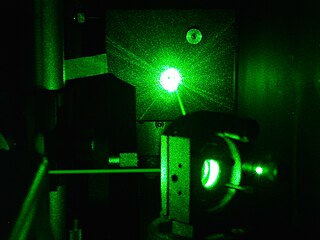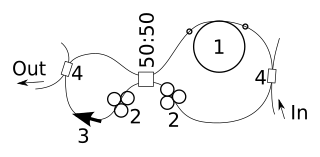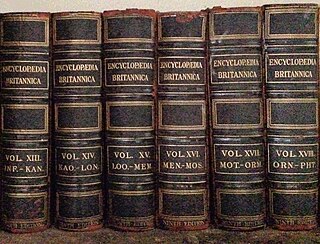
The Optical Society is a scientific society dedicated to advancing the study of light—optics and photonics—in theory and application, by means of publishing, organizing conferences and exhibitions, partnership with industry, and education. The organization has members in more than 100 countries. As of 2018, the OSA had over 21,000 individual members and more than 265 corporate member companies.

Photonic-crystal fiber (PCF) is a class of optical fiber based on the properties of photonic crystals. It was first explored in 1996 at University of Bath, UK. Because of its ability to confine light in hollow cores or with confinement characteristics not possible in conventional optical fiber, PCF is now finding applications in fiber-optic communications, fiber lasers, nonlinear devices, high-power transmission, highly sensitive gas sensors, and other areas. More specific categories of PCF include photonic-bandgap fiber, holey fiber, hole-assisted fiber, and Bragg fiber. Photonic crystal fibers may be considered a subgroup of a more general class of microstructured optical fibers, where light is guided by structural modifications, and not only by refractive index differences.

SPIE is an international not-for-profit professional society for optics and photonics technology, founded in 1955. It organizes technical conferences, trade exhibitions, and continuing education programs for researchers and developers in the light-based fields of physics, including: optics, photonics, and imaging engineering. SPIE is most known for Photonics West, held in San Francisco.

Applied physics is intended for a particular technological or practical use. It is usually considered as a bridge or connection between physics and engineering.

Arthur Ashkin is an American scientist and Nobel laureate who worked at Bell Laboratories and Lucent Technologies. Ashkin has been considered by many as the father of optical tweezers, for which he was awarded the Nobel Prize in Physics 2018 at age 96, becoming the oldest Nobel Laureate. He resides in Rumson, New Jersey.
Axel Scherer is the Bernard Neches Professor of Electrical Engineering, Physics, and Applied Physics at the California Institute of Technology. He is also a Distinguished Visiting Professor at Thayer School of Engineering at Dartmouth College. He is known for fabricating the world's first semiconducting vertical-cavity surface-emitting laser (VCSEL) at Bell Laboratories. In 2006, Dr. Scherer was named the director of the Kavli Nanoscience Institute. He graduated from New Mexico Institute of Mining and Technology in 1985. At Caltech he teaches a very popular freshman lab course on semiconductor device fabrication: Applied Physics 9ab, for which he wrote the textbook for the course.
A photonic integrated circuit (PIC) or integrated optical circuit is a device that integrates multiple photonic functions and as such is similar to an electronic integrated circuit. The major difference between the two is that a photonic integrated circuit provides functions for information signals imposed on optical wavelengths typically in the visible spectrum or near infrared 850 nm-1650 nm.

The Vulcan laser is an infrared, 8-beam, petawatt neodymium glass laser at the Rutherford Appleton Laboratory's Central Laser Facility in Oxfordshire, United Kingdom. It was the facility's first operational laser.
An ultrashort pulse laser is a laser that emits ultrashort pulses of light, generally of the order of femtoseconds to ten picoseconds. They are also known as ultrafast lasers owing to the speed at which pulses "turn on" and "off"—not to be confused with the speed at which light propagates, which is determined by the properties of the medium, particularly its index of refraction, and can vary as a function of field intensity and wavelength.
Luxtera Inc., founded in 2001, is based in Carlsbad, California. Luxtera is a fabless semiconductor company that is using silicon photonics technology to build complex electro-optical systems in a production silicon CMOS process. It is the first company on the market with a product that monolithically incorporates active optics for data communications manufactured with low-cost silicon-based chip processing.

Charles H. Henry was an American physicist. He was born in Chicago, Illinois. He received an M.S. degree in physics in 1959 from the University of Chicago, and a Ph.D. degree in physics in 1965 from the University of Illinois, under the direction of Charlie Slichter. In March 2008, he was featured in an article in the Physics Illinois News, a publication of the Physics Department of the University of Illinois.
Phosphate glass is a class of optical glasses composed of metaphosphates of various metals. Instead of SiO2 in silicate glasses, the glass forming substrate is P2O5.
The mosquito laser is a device invented by astrophysicist Lowell Wood to kill large numbers of mosquitoes to reduce malaria infection rates. Although originally introduced in the early 1980s, the idea was not substantially researched until decades later. In 2007, the Bill & Melinda Gates Foundation requested Intellectual Ventures LLC to find a way to fight and eventually end malaria. Intellectual Ventures resurrected the idea of using lasers to kill mosquitoes and now has a working prototype. The idea has been criticized because most areas where malaria is prevalent do not have reliable electrical power.
In the term mode coupling, as used in physics and electrical engineering, the word "mode" refers to eigenmodes of an idealized, "unperturbed", linear system. The superposition principle says that eigenmodes of linear systems are independent of each other: it is possible to excite or to annihilate a specific mode without influencing any other mode; there is no dissipation. In most real systems, however, there is at least some perturbation that causes energy transfer between different modes. This perturbation, interpreted as an interaction between the modes, is what is called "mode coupling".

A figure-8 laser is a fiber laser with a figure-8-shaped ring resonator. It is used for making pico- and femtosecond soliton pulses. The typical spectrum of such a laser consists of a wide central peak and a few narrow lateral peaks that are placed symmetrically around it. The amplitudes of the narrow peaks are the same as or less than that of the central peak.
Physical Review Applied is a peer-reviewed, scientific journal, published by the American Physical Society (APS). The Editor of Phys. Rev. Applied is Stephen R. Forrest and it published 430 papers in 2017 on the subject of applied physics. It is part of the Physical Review family of journals.
In infrared optical communications, C-band refers to the wavelength range 1530–1565 nm, which corresponds to the amplification range of erbium doped fiber amplifiers (EDFAs).
Shun Lien Chuang was an American engineer, scientist, Fellow of the IEEE, OSA, APS and JSPS, and Professor at the University of Illinois at Urbana-Champaign.

(James) Roy Taylor is Professor of Ultrafast Physics and Technology at Imperial College London.

Donna Theo Strickland is a Canadian optical physicist and pioneer in the field of pulsed lasers. She was awarded the Nobel Prize in Physics in 2018, together with Gérard Mourou, for the invention of chirped pulse amplification. She is a professor at the University of Waterloo.











